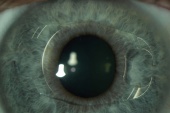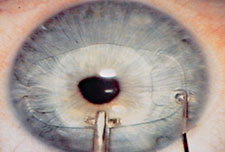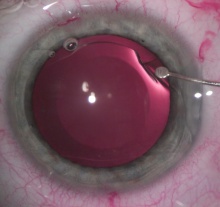Phakic Intraocular Lenses
All content on Eyewiki is protected by copyright law and the Terms of Service. This content may not be reproduced, copied, or put into any artificial intelligence program, including large language and generative AI models, without permission from the Academy.
Background of Refractive Error
Clinically significant refractive error, or ametropia, affects half of the general population in the United States. Significant ametropia includes hyperopia of 3.0 diopters (D) or greater, myopia of 1.0 D or greater, and astigmatism with a cylinder of 1.0 D or greater[1]. Presence of ametropia and severity vary by gender, ethnicity, age, and anatomy. Correcting ametropia at a young age is important to accomplish in order to prevent complications such as accommodative esotropia or refractive amblyopia.
Extraocular interventions include glasses, contact lenses, and cornea-modifying surgery. Myopia can be corrected with glasses and contact lenses using a spherical concave or diverging lens with minus D, which shifts the focus of light rays from anterior to the retina, to the retina. Hyperopia can be corrected with a spherical convex or converging lens with positive D, which shifts the focus from posterior to the retina, to the retina. Astigmatism is corrected using a toric contact lens or cylindrical glass lens, which refocus light rays in two separate planes to compensate for an ovoid cornea.
Most forms of surgery for ametropia have the goal of reshaping the cornea using a high-energy excimer laser or a femtosecond laser. The various techniques include photorefractive keratectomy (PRK), transepithelial PRK (TransPRK), laser in situ keratomileusis (LASIK) along with its variations of sub-Bowman keratomileusis and epi-LASIK, and SMILE procedure (SMall Incision Lenticule Extraction). Another surgery is intrastromal corneal rings (INTACS), which are implants that reshape the cornea.
Options for intraocular surgery include refractive lens exchange, which is essentially the same procedure as cataract surgery and phakic intraocular lens (pIOL) implants which will be the focus of discussion here. Bioptics combines laser surgery and phakic intraocular lens for correction of high degrees of ametropia.
History
The first pIOLs were placed in the anterior chamber angle as early as 1953 by Dr. Strampelli [2]. These lenses were plagued with endothelial decompensation, angle fibrosis which led to subsequent glaucoma, and pupil distortion. Due to the significant complications experienced with these lenses nearly 30 years transpired before new lens designs began to emerge [3].
Advances in intraocular lens technology benefited the refractive surgeon when better materials and lens designs surfaced. Polymethylmethacrylate (PMMA) lens materials became prevalent as well as z-shaped haptics which would contact the angle structures less than prior lens designs. Acrylic became popular as well due to the successful use in cataract surgery intraocular lens replacement.
In 1977, Jan Worst introduced the iris-fixated “iris-claw” which was a biconcave design made from PMMA. This lens avoided many of the glaucoma and endothelial complications. [4].
Posterior chamber pIOLs came into existence in 1986 and were first developed by Dr. Fyodorov. The design later inspired the current model used by STAAR Surgical, the Visian implantable collamer lens (ICL). This lens is made of a trademark material known as “collamer,” which is a copolymer of hydroxyethyl methacrylate and porcine collagen [4].
Available pIOLs
Implantable pIOLs come in two broad varieties: Anterior Chamber Intraocular Lenses (ACIOLs) and PCIOLs. ACIOLs can be further divided into angle-supported ACIOLs and iris-claw ACIOLs. In the United States, the only currently FDA-approved models are the iris-claw ACIOL Verisyse (Abbott Laboratories Inc, Abbott Park, IL, USA, Figure 1) and the PCIOL Visian ICL (Staar Surgical, Monrovia, CA, USA, Figures 2 & 3). The Verisyse lens is branded Artisan (Ophtec BV, The Netherlands) in Europe.
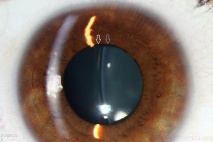
Newer models are in clinical trials in the United States and are already being used in Europe, having the CE mark of approval. The Artiflex is the foldable version of the Artisan iris-claw ACIOL and is available in Europe. The United States equivalent of the Artiflex is the Veriflex, which is currently in trials.
Most lens brands are created in negative and positive D, and have toric forms available with and without correction of myopia or hyperopia. The Visian and Verisyse are both FDA-approved only for correction of myopia with or without astigmatism up to 2.5 D.[6] In 2018, the toric version of the Visian ICL was FDA approved. In March 2022, the Evolution (EVO/EVO+) version of the spherical and toric Visian ICL was approved by the FDA. The advance is the innovative 360-micron diameter central port that facilitates the physiologic flow of aqueous humor, eliminating the need for peripheral iridotomies prior to implantation. In addition to reducing the risk of angle closure, it may also reduce the risk of anterior subcapsular cataracts.
The AcrySof (Alcon, Switzerland, Figure 4) is an angle-supported ACIOL withdrawn from the market due to excessive endothelial cell loss.
Indications and Contraindications
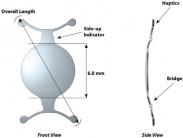
While pIOLs are available in prescriptions for ametropia ranging from mild to severe, implantation of pIOLs is typically recommended for more severe degrees of refractive error. The ideal candidates are >21 years old, have had stable refraction (change in vision <0.5 D) over at least one year, are poor candidates for excimer laser surgery, have poor tolerance of contact lenses or glasses, have irido-corneal angle >30 degrees, have central endothelial cell count >2300 cells/mm2 or >2500 if >21 years old and >2000 if >40 years old, and have a mesopic pupil size <5-6 mm. Candidates requiring careful consideration or contraindication for implantation are those with active anterior segment disease, recurrent or chronic uveitis, cataracts, previous ocular surgery, glaucoma or IOP >21mmHg, preexisting macular pathology, retinal disease, anomalous irises or pupils, or systemic diseases classically associated with poor postoperative healing (eg diabetes mellitus, connective tissue disease, autoimmune disease)[6].
Calculations
Lens companies typically provide software that will calculate the correct lens after entering patient measurements. Lens makers typically provide a nomogram that a provider can use to choose the proper lens strength based upon measurement of patient anatomy. ACIOL power is calculated using a Van der Hejde nomogram, which requires the patient’s refraction, keratometry, and anterior chamber depth (ACD). [8] PCIOL power is calculated using a Binkhorst nomogram which requires a patient’s spectacle plane refraction, corneal power, and ACD. PCIOLs may also require a measurement of the angle-to-angle distance (or white to white) for appropriate sizing of lens diameter. [8] Ultimately, providers enter patient measurements into software that uses formulas proprietary to the manufacturers and provides a phakic IOL power that is ideally within 0.5-1.0 D of emmetropia with as close to 20/20 vision as can be attained. Newer lenses may require other patient measurements and use alternate formulas and nomograms not mentioned above.
There are several methods used to obtain the variables that are required to calculate pIOL power. Refraction can be performed by manifest refraction or autorefraction. ACD and angle-to-angle distance are best-obtained using optical coherence tomography (OCT), but can also be measured using ultrasound biomicroscopy (UBM) or Scheimpflug imaging. ACD is measured from the corneal apex to the anterior surface of the crystalline lens, and is use to calculate effective lens position (ELP) in PCIOLs by substracting the distance between the pIOL and the crystalline lens from the ACD. The ELP is typically 0.8mm in the Artisan/Verisyse lens.[9] White-to-white (WTW) measurement with an IOL-Master or calipers can be used to estimate angle-to-angle distance. Corneal power is calculated using keratometry or topography to measure the curvature of the cornea.[6][9] Different nomograms optimized PCIOL (Visian ICL) sizing based on swept-source anterior segment optical coherence tomography.[10] Ideally the distance between the PCIOL and the crystalline lens (vault) should vary between 200 and 800 microns and can be measured by anterior segment OCT (figure 9).
Surgical Technique
In general, peripheral iridotomies are strongly recommended to prevent pupillary block for both anterior and posterior pIOLs. Newer version of the Visian ICL (EVO/EVO+ ) includes a central port and a peripheral iridotomy is not indicated. Anterior chamber pIOLs require miotic drops to reduce pupils size. Main incisions are typically performed on the steep corneal axis to reduce surgically induced astigmatism. Details of surgical techniques differ slightly depending on the specific type of pIOLs being used.
The Verisyse/Artisan iris-claw ACIOL implantation (Figure 5) is typically done with retrobulbar or peribulbar anesthesia and induced miosis. As this lens must be centered over the iris, the cornea center should be marked to aid the surgeon’s placement. Toric lenses must be implanted carefully so as to avoid cyclotorsion of the lens over the pupil. A corneal or scleral incision is made along with two paracenteses for lens manipulation. OVD is injected into the AC followed by the pIOL, which is then fixated into the iris using an enclavation needle to hold the iris and an implantation forceps to depress the claw into the iris. Centration of the lens over the pupil is essential, and mild ovalization after the surgery is not uncommon due to the effect of the miotic agent. Intraoperative peripheral iridectomy or two preoperative neodymium:YAG (Nd:YAG) laser iridotomy should be done to prevent pupillary block. The incision is large enough to require 10-0 nylon sutures.
Verisyse implantation video (Vislisel J and Goins K. Verisyse phakic intraocular lens placement. Retrieved from https://vimeo.com/142181115. Licensed under CC BY 3.0.): https://vimeo.com/142181115
The foldable Veriflex/Artiflex iris-claw ACIOL allows for a smaller, watertight incision and is installed similar to the Verisyse/Artisan lens once it has been unfolded in the anterior chamber.
The success of Visian ICL implantation (Figure 6) begins with proper loading of the ICL into the injector. The cartridge is filled with OVD, loaded with the lens dome-up being careful not to rupture the footplates, and covered with a foam tip. Preoperative mydriasis is necessary. A 3.0mm incision is sufficient for injection, along with one or two paracenteses depending on surgeon preference. The pIOL is injected bevel-down after the AC is filled with OVD. A blunt spatula is used to press the haptics under the iris, miosis is pharmacologically induced but not always recommended, the OVD is extracted, and the AC is rehydrated. Intraoperative peripheral iridectomy or two preoperative Nd:YAG laser iridotomies should be performed to prevent pupillary block in the first version of the Visian ICL.
Visian ICL implantation video: https://youtu.be/LIsZz5y7QOY
The PRL is installed similar to the Visian ICL, with one difference being that two peripheral iridotomies are performed after implantation.[4][6][11]
The AcrySof foldable angle-supported ACIOL implantation requires a miotic pupil and topical anesthesia. An ophthalmic viscosurgical device (OVD) is injected into the anterior chamber, followed by the pIOL through a 2.6mm or 3.2mm incision, depending on the lens size. Intraoperative gonioscopy can be used to confirm placement of the haptics in the angle. The OVD is removed and the AC is then rehydrated. A 10-0 nylon suture may be used if the incision is >3.0 mm. This lens is not available in the market anymore.
Clinical outcome
Phakic IOL surgery has been shown to give better vision, have higher patient satisfaction, and avoids the risk of corneal ectasia[12]. Phakic IOLs have better best spectacle-corrected visual acuity (BSCVA) and refractive predictability and stability compared with LASIK and PRK and have very high satisfaction rates [12]. Implantation of pIOLs forgoes the risks of corneal ectasia associated with excimer laser surgery and refractive lens exchange, respectively.
Comparative studies on pIOLs show conflicting results on outcomes of the different pIOLs in circulation. In FDA trials, Iris-fixated ACIOLs have been shown to have 20/40 uncorrected visual acuity (UCVA) or better in 84% of patients after three years and posterior chamber pIOLs have been shown to have an UCVA of 20/40 or better in 81% of patients after 3 years.[4] Artiflex/Veriflex and Visian ICL show better outcomes in highly myopic eyes than Artisan/Verisyse. Artisan/Verisyse lenses also have greater rates of higher order aberrations compared with other lenses. One study showed a 31.7% higher rate of emmetropia in Artiflex/Veriflex lenses than Artisan/Verisyse lenses[13]. The foldable Artiflex/Veriflex lenses also heal faster postoperatively due to the smaller incision size.
In a review article about the efficacy and safety of pIOL implantation for the correction of hyperopia and hyperopic astigmatism, it was found that the current two phakic IOLs used to correct hyperopia ( anterior chamber iris-fixated pIOLs and posterior chamber implantable collamer lenses) are safe and effective with no serious events. It concluded that implantation of pIOLs might be the optimal refractive surgery for the correction of high hyperopia. [14]
A 2009 metanalysis concluded that the placement of phakic ICL implants is effective and safe and allows stable refractive results for the treatment of moderate and severe myopia with a good refractive stability over nearly 8 years of follow-up. In strong ametropia (myopia beyond 8 diopters) the quality of vision obtained after placing an intraocular implant is superior to that obtained by corneal laser surgery[4].
A study comparing ICL vs SMILE in high myopia (-6 to -10 D) showed ICL implantation yielded better refractive accuracy, better uncorrected distance visual acuity, fewer higher order aberrations, and better subjective quality of vision than SMILE .[15] A comparison study for low myopia also showed comparable safety, efficacy, long-term visual stability, and high patient satisfaction. The most common visual complaint was halo after ICL and starburst after SMILE. [16]
Risks and Complications
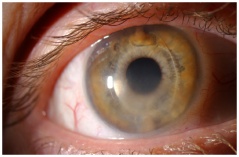
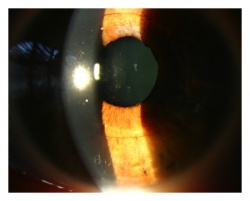
There are concerns for inflammation, infection, and bleeding resulting from surgical trauma especially to the iris. Since some of these procedures entail larger corneal and scleral incisions, the risk of endophthalmitis and retinal detachment are notable risks. Elevated intraocular pressures from pupillary block and angle scarring are concerning due to insertion of a pIOL in or near the angle. Chronic intraocular pressure elevation can produce permanent vision loss. The surgical procedure can also induce endothelial cell damage and if the pIOL is in close proximity to the cornea, and chronic endothelial cell loss can lead to corneal decompensation (Figure 7). Finally, chronic inflammation or prosthetic-lens touch can induce cataract formation (Figure 8)[2].
The complication rate of pIOLs utilized today is dramatically lower than historical models due in large part to advances in imaging modalities used to properly size the lenses. Complications most often arise as a direct result of improper sizing of the lens, and vary depending on the type of lens used [19]. Explantation or reoperation have been necessary after implantation due to anterior subcapsular cataract development, unacceptable endothelial cell loss, pupil ovalization, lens subluxation or dislocation, refractive error, and pigment dispersion glaucoma.[20] [21]
While patients with pIOLs have had macular hemorrhage and retinal detachment, there has been no proof of causation between the pIOL and those morbidities since they occurred in the context of trauma. Endothelial cell loss can sometimes be confounded by the patient rubbing their eyes often after surgery.
The location of PCIOLs predisposes the crystalline lens and the iris to come into contact with the pIOL, leading to the specific complications of pigment dispersion with possible secondary glaucoma and anterior subcapsular cataracts. A PCIOL that is too long may cause angle-closure or pigmentary dispersion glaucoma, and a PCIOL that is too short may lead to anterior subcapsular cataracts.[6] Newer version of the Visian ICL (EVO) with central port seems to induce much lower complications. No visually significant cataracts have been reported to date following EVO implantation with up to 5 years of follow-up in a study, and the incidence of nonvisually significant ASC opacities has remained low. Preclinical studies suggest that the central port helps to maintain the health of the crystalline lens by allowing physiologic flow of aqueous humor across the anterior lens capsule. [22]
Angle-supported ACIOLs tend to cause chronic endothelial cell loss from the cornea, pupil ovalization, and nuclear cataract formation.[21] . Currently, they are mainly use in aphakia and are not recommended for the treatment of ametropia in young patients. Iris-claw ACIOLs tend to encounter chronic endothelial cell loss and cataracts.[20] The progressive corneal endothelial cell loss remains a matter of concern in Iris-claw ACIOLs and limits their indication for ametropia treatment in young phakic patients.[23]
References
- ↑ Vitale, S., et al., Prevalence of refractive error in the United States, 1999-2004. Arch Ophthalmol, 2008. 126(8): p. 1111-9.
- ↑ Jump up to: 2.0 2.1 Chen, L.J., et al., Metaanalysis of cataract development after phakic intraocular lens surgery. J Cataract Refract Surg, 2008. 34(7): p. 1181-200.
- ↑ Praeger, D.L., A. Momose, and L.L. Muroff, Thirty-six month follow-up of a contemporary phakic intraocular lens for the surgical correction of myopia. Ann Ophthalmol, 1991. 23(1): p. 6-10.
- ↑ Jump up to: 4.0 4.1 4.2 4.3 4.4 Huang, D., et al., Phakic intraocular lens implantation for the correction of myopia: a report by the American Academy of Ophthalmology. Ophthalmology, 2009. 116(11): p. 2244-58.
- ↑ Redd T, V.J., Larson TL, Goins KM. Phakic intraocular lenses for high myopia. March 4, 2015; Available from: http://EyeRounds.org/cases/210-PhakicIOL.htm.
- ↑ Jump up to: 6.0 6.1 6.2 6.3 6.4 Guell, J.L., et al., Phakic intraocular lenses part 1: historical overview, current models, selection criteria, and surgical techniques. J Cataract Refract Surg, 2010. 36(11): p. 1976-93.
- ↑ Pineda, R., 2nd and T. Chauhan, Phakic Intraocular Lenses and their Special Indications. J Ophthalmic Vis Res, 2016. 11(4): p. 422-428.
- ↑ Jump up to: 8.0 8.1 Cataract and Refractive Surgery. Essentials in Ophthalmology, ed. T. Kohnen and D.D. Koch. 2005: Springer-Verlag Berlin Heidelberg.
- ↑ Jump up to: 9.0 9.1 Williams, G. and M. Muhtaseb Biometry Calculations for Phakic IOLs. Cataract & Refractive Surgery Today Europe, 2011.
- ↑ Tomoaki Nakamura, MD, Naoki Isogai, CO, Takashi Kojima, MD, PhD, Yoko Yoshida, MD, Yasuo Sugiyama, PhD. Optimization of implantable collamer lens sizing based on swept-source anterior segment optical coherence tomography. . J Cataract Refract Surg 2020; 46:742–748
- ↑ Hassaballa, M.A. and T.A. Macky, Phakic intraocular lenses outcomes and complications: Artisan vs Visian ICL. Eye (Lond), 2011. 25(10): p. 1365-70.
- ↑ Jump up to: 12.0 12.1 Barsam, A. and B.D. Allan, Excimer laser refractive surgery versus phakic intraocular lenses for the correction of moderate to high myopia. Cochrane Database Syst Rev, 2014(6): p. CD007679.
- ↑ Karimian, F., et al., Comparison of three phakic intraocular lenses for correction of myopia. J Ophthalmic Vis Res, 2014. 9(4): p. 427-33.
- ↑ Alshamrani AA, Alharbi SS. Phakic intraocular lens implantation for the correction of hyperopia. J Cataract Refract Surg. 2019 Oct;45(10):1503-1511. doi: 10.1016/j.jcrs.2019.05.051. [[[Link]]]
- ↑ Siedlecki J, Schmelter V, Mayer WJ, Schworm B, Priglinger SG, Dirisamer M, Luft N. SMILE Versus Implantable Collamer Lens Implantation for High Myopia: A Matched Comparative Study. J Refract Surg. 2020 Mar 1;36(3):150-159. doi: 10.3928/1081597X-20200210-02. Erratum in: J Refract Surg. 2020 May 1;36(5):352. PMID: 32159819.
- ↑ Fu M, Li M, Xian Y, Yu Z, Zhang H, Choi J, Niu L, Wang X, Zhou X. Two-Year Visual Outcomes of Evolution Implantable Collamer Lens and Small Incision Lenticule Extraction for the Correction of Low Myopia. Front Med (Lausanne). 2022 Apr 13;9:780000. doi: 10.3389/fmed.2022.780000. PMID: 35492322; PMCID: PMC9043127.
- ↑ Moshirfar, M., et al., Incidence rate and occurrence of visually significant cataract formation and corneal decompensation after implantation of Verisyse/Artisan phakic intraocular lens. Clin Ophthalmol, 2014. 8: p. 711-6.
- ↑ Taneri, S., S. Oehler, and C. Heinz, Inflammatory response in the anterior chamber after implantation of an angle-supported lens in phakic myopic eyes. J Ophthalmol, 2014. 2014: p. 923691.
- ↑ Chang, D.H. and E.A. Davis, Phakic intraocular lenses. Curr Opin Ophthalmol, 2006. 17(1): p. 99-104.
- ↑ Jump up to: 20.0 20.1 Guell, J.L., et al., Five-year follow-up of 399 phakic Artisan-Verisyse implantation for myopia, hyperopia, and/or astigmatism. Ophthalmology, 2008. 115(6): p. 1002-12.
- ↑ Jump up to: 21.0 21.1 Alio, J.L., et al., Angle-supported anterior chamber phakic intraocular lens explantation causes and outcome. Ophthalmology, 2006. 113(12): p. 2213-20.
- ↑ Packer M. The Implantable Collamer Lens with a central port: review of the literature. Clin Ophthalmol. 2018;12:2427‐2438. Published 2018 Nov 27. doi:10.2147/OPTH.S188785
- ↑ Landesz M, Worst JG, van Rij G. Long-term results of correction of high myopia with an iris claw phakic intraocular lens. J Refract Surg. 2000;16(3):310‐316.


